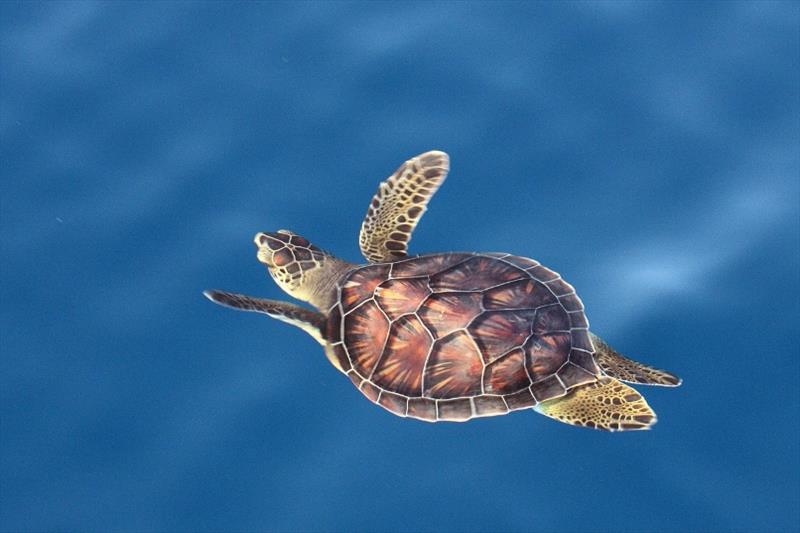
Sea Turtle Week 2020: Celebrating sea turtle conservation
by NOAA Fisheries 22 Jun 2020 15:32 UTC

A juvenile green turtle swimming in the open ocean © Our Sea Turtles. Blair and Dawn Witherington
NOAA Fisheries is committed to the protection, conservation, and recovery of sea turtles. We conduct research to inform conservation management actions and we work closely with our partners to advance conservation and recovery of these amazing animals.
Celebrating Sea Turtles
Welcome to Sea Turtle Week!
Join us in celebrating these charismatic species and learn more about our conservation efforts from Donna Wieting, Director, Office of Protected Resources.
Read this leadership message on sea turtles
10 tremendous turtle facts
Sea turtles are magnificent creatures. Check out these turtle facts to learn something new about them.
Learn more about sea turtles
Threats turtles face
Bycatch is a serious threat
The greatest threats to sea turtles are human-caused. Globally, bycatch in commercial fisheries remains the greatest threat to sea turtles in their marine environment.
NOAA has led numerous efforts to develop ways to reduce sea turtle bycatch and to minimize the harm that results from bycatch. Our efforts have focused on the development of Turtle Excluder Devices (TEDs) to allow sea turtles to escape from trawl fishing nets, development of large circle hook and bait combinations to reduce the capture of sea turtles during longline fishing and, most recently, research to reduce sea turtle bycatch in gillnets by adding lights to the net.
TEDs reduce bycatch in trawl nets, most notably shrimp trawls. A TED is a metal grid that is installed in the trawl near the back end along with a covered escape opening cut into the net. With this net adaption installed correctly, target catch like shrimp pass between the bars and get caught in the net, while large animals like sea turtles bump against the metal grid and escape through a mesh flap.
NOAA Fisheries recently expanded TED requirements to part of the skimmer trawl fishery (a different way of fishing for shrimp), this will reduce the number of turtles caught and killed in this fishery. NOAA continues to work with the shrimp industry to ensure TEDs are working properly and to provide outreach and training to the industry.
Illuminated nets could provide a brighter future for sea turtles
The first testing of lighted gillnets began about a decade ago. Testing has continued using different types of lights and different configurations of lights on the gear. Observed decreases in the number of sea turtles bycaught suggest that illuminating gillnets may be an effective sea turtle bycatch reduction tool for certain gillnet fisheries that operate at night.
Learn more about lighted gill nets
Species in the spotlight
Of all the species NOAA Fisheries protects under the Endangered Species Act, we are shining a spotlight on nine species that are among the most at risk of extinction. Most of these species are threatened by human activities such as bycatch in fisheries, habitat destruction, vessel strikes, entanglement in marine debris,and ocean noise. Our Species in the Spotlight program is aimed at stabilizing these species, and bringing them back from the brink of extinction.
Vessel strikes harm sea turtles
See how Dr. Brian Stacy, a veterinarian who works in NOAA Fisheries National Sea Turtle Program, examines sea turtle health, welfare, and mortality. Part of his work involves investigating causes of sea turtle strandings, including vessel strikes.
Sea turtle research advances conservation efforts
Sea turtle fingerprints help unlock population secrets
Decoding hatchling DNA allows us to understand the hatchling's family history, including who its mother is, who its father is, and to what nesting population it belongs. These clues are helping scientists unlock the secrets of where population boundaries are, where to focus conservation efforts, and what threats might be population specific.
Learn more about sea turtle "fingerprint" research in St. Croix, U.S. Virgin Islands
Researching hawksbill turtles
Hawksbill turtles are an endangered species. Once abundant, they were killed in large numbers over the past hundred years for their shells, used to make "tortoise shell" jewelry and trinkets. This large scale killing of the species nearly drove the population to extinction. Today, the Convention on International Trade of Endangered Species (CITES) forbids the trade of any turtle products on the international market, including the "tortoise shell" from hawksbill turtles.
Saving sea turtles: How you can help
From protecting beach habitats to reporting sick or injured turtles, learn what actions you can take to help save sea turtles.
Learn what you can do to save sea turtles
Share five ways you can help sea turtles with your friends